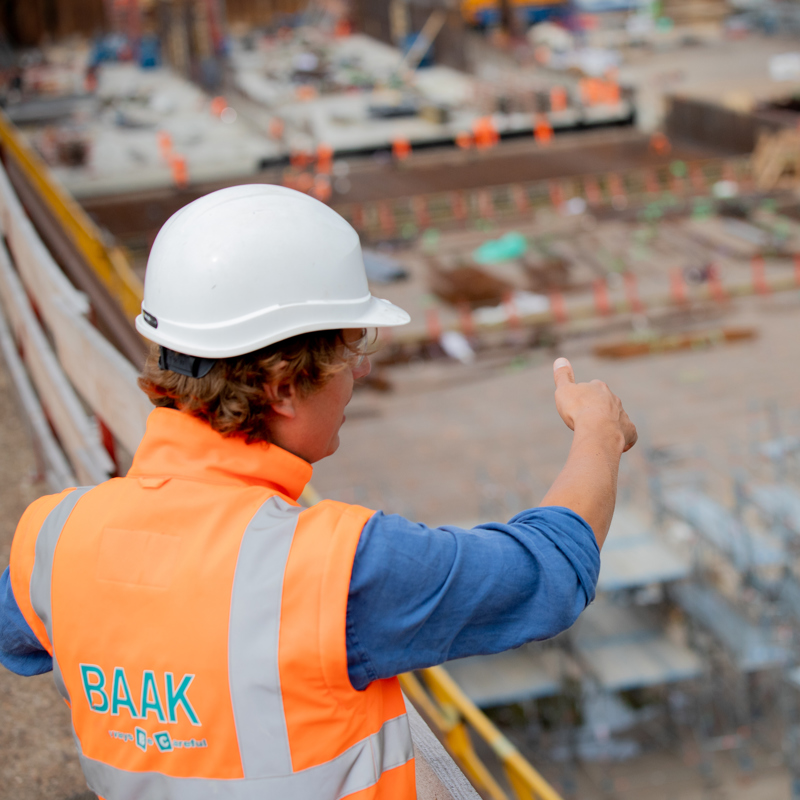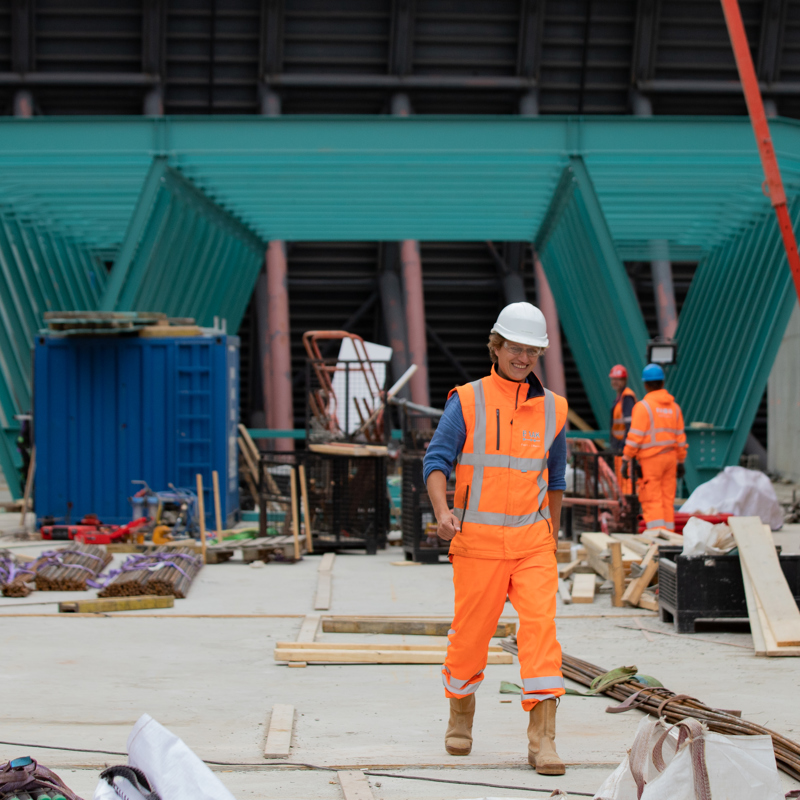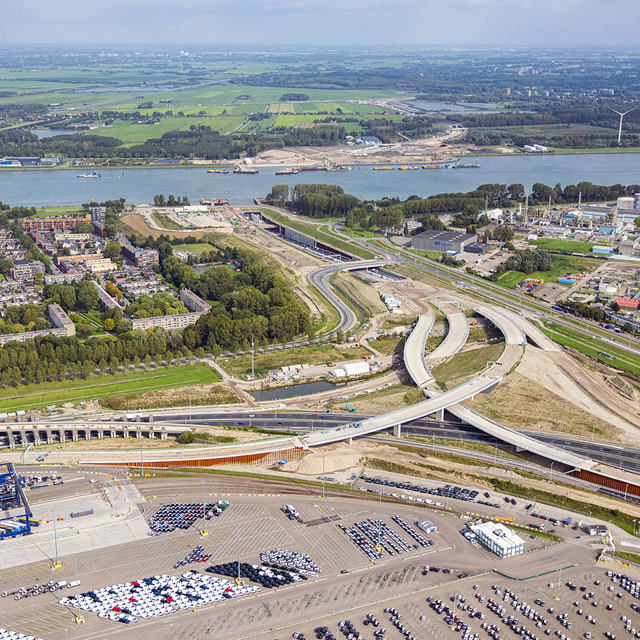This is how we build the immersed tunnel elements for the Maas Delta Tunnel
A challenge? That is putting it mildly. In a gigantic construction dock in Rotterdam, we are building two tunnel elements of about 200 metres long, 42 metres wide and 8 metres high.
In the middle of the construction dock, Fern van Efferink looks around. "Actually, you should come by here every week to see the major changes. So much happens here. In a relatively small area."
Ballast Nedam is building the immersed elements of the Maas Delta Tunnel within the BAAK consortium. In his role as Work Planner, every day of Fern's work is dedicated to these two elements. He prepares the work, coordinates choices with colleagues and partners and - not unimportantly - walks around outside to see the elements grow. It is a high-profile project. Or, as Fern says: "A building site like this is truly beautiful to observe."
We list six of the greatest peculiarities of the immersed tunnel elements:
#1: From six to two elements
Let's go back in time a few years. During the tendering process, the BAAK consortium, a combination of Ballast Nedam, DEME and Macquarie Capital, studied the Rijkswaterstaat reference design. Because the immersed tunnel will be situated in the busy port area of Rotterdam, the surroundings and execution will benefit from a working method with little nuisance and few risks for the planning. Consortium BAAK therefore came up with an alternative plan in which various solutions were created for the complex elements of the reference design. In this plan, the length of the immersed part of the tunnel is reduced, so that we can build the Maas Delta Tunnel with two larger immersed elements instead of six smaller ones. This saves four large operations, which means less disruption to shipping and less risk of planning changes. After sinking, the elements connect to the land heads on the shore, which, according to this design, will be built deeper and further into the river 'het Scheur'.
#2: Building big on a small site
The Damen Verolme construction dock in Rotterdam cannot be described as small, but with the two gigantic tunnel elements, it gets crowded easily . The construction dock is a stone's throw away from our building site in Rozenburg. The dimensions of the elements limit the space available for us to carry out our work. An efficient way of working is a must.
We not only work efficiently, but also fast. Construction of the immersed elements started in June 2021 and is estimated to be completed in early 2022. After construction, we will seal the elements with steel headboards and drive them up into the relatively small dry dock. We then rotate the elements slightly, so that we can take them out one by one. They are parked in the neighbouring harbour, where the tunnel elements are prepared for the sinking process. From there, they are transported to the Scheur and immersed.
#3: Parallel work
The construction of the immersed elements is divided into parts, also called 'slots'. Element North consists of eight slots and element South has seven. In each section, we first pour the floor, then the walls between the driving shafts and finally the outer walls and the roof. This means that one slot of the element is made in three pours of concrete. Convenient, because it is fast and ensures that there are as few pouring joints as possible between the different parts. This method provides the perfect opportunity for a learning curve, because the repetitive work makes the construction train run more smoothly.
We build a slot in a two-week cycle. This means that there is one week's difference between the progress of the tunnel element on the north bank and the tunnel element on the south bank. The construction of the two tunnel elements is thus in line with each other and we create an 'own' pouring day for each element. On Wednesday we pour a floor section of one element, on Thursday the central walls and on Friday a wall roof section. The following week we do exactly the same for the other element.


#4: An extra tube
Immersed elements must always have a certain weight that allows them to float when needed and to stay in place once sunk. That's why we add extra weight during construction, so that we are working with exactly the right amount of weight. The question is: where does the weight go? The top and bottom sides are out of the question, as we cannot add extra height to the elements. This height is limited, as the elements must connect to the other tunnel sections on both banks.
The solution is as follows: On the side, we build an extra tube which we later fill with concrete. While this extra tube is being built, we are already thinking about the next construction stages of the tunnel. Do we have to pour in the pipes already? Do we need to install facilities? Or will we stick to concrete only? We made these choices during the design process.
#5: You don't see this kind of prestress often
The transverse prestressing makes the design lower and more narrow. This works as follows: we incorporate tubes in the floors and the roof of the cantilever element. After the concrete has been poured, strands are inserted. When the concrete is sufficiently hard, these strands are tightened and tensioned using heavy-duty jacks. Then we can finish the last part of the floor, also called 'the toe'.
#6: Cooperation with Strukton
We do not undertake this project alone. Besides Ballast Nedam, consortium partner DEME plays an important role in this operation. The BAAK consortium is also being assisted by Strukton. This so-called 'A-Team' has been involved in the construction plans and the design since the start of the tender, and is working on an optimal execution of the process. One of the choices we made thanks to this cooperation is to opt for steel end walls, which we can use to seal the tunnel elements before sinking. This way, we can easily let the elements float when the time is right.
Once you get the hang of it, you can't let it go
A real specialism
Until the beginning of 2022, this construction dock will be used to build the two immersed tunnel elements. Then, when the elements are floating in the hearbor nearby, we wait until our colleagues on the north and south bank have finished building the land heads. Then we start the long-awaited sinking operation in which the elements are put in place, at a depth of about 27 metres. And then? After the necessary work on the technical installations, road construction and finishing, the new Maas Delta Tunnel is a fact.
"Constructing immersed tunnels is a real specialism," says Fern. "Once you've got the hang of it, you can't let go. It's simple, really. We build a tube, a big shoebox. At the same time, we are constantly working on the scales of gravity and Archimedes' law. That's what makes it so fascinating."






